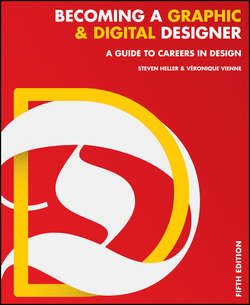Читать книгу Becoming a Graphic and Digital Designer - Heller Steven - Страница 11
На сайте Литреса книга снята с продажи.
Part 1
Graphic Design
Chapter 1
Inspirations and Motivations
Gail Anderson
The Joys of Print Design
ОглавлениеA specialist in conceptual typography, Gail Anderson, a New York–based designer, is a partner at Anderson Newton Design. From 2002 through 2010, she was creative director of design at SpotCo, a New York City advertising agency that creates posters, advertisements, and commercials for Broadway and institutional theater. From 1987 to early 2002, she worked at Rolling Stone magazine, as designer, deputy art director, and finally as the magazine's senior art director. Anderson's accomplishments are many: she teaches at the School of Visual Arts, serves on the boards for The Citizens Stamp Advisory Committee and the Type Directors Club, and is the recipient of the 2008 Lifetime Achievement Medal from the American Institute of Graphic Arts; she is also coauthor, with Steven Heller, of The Typographic Universe, New Modernist Type, New Ornamental Type, and New Vintage Type. ”Graphic design has changed in just about every way possible,” she notes, “especially in terms of technology. In my last year at SVA, the design department began to tout its first computer class, to be taught on what were Apple CII's. I didn't sign up, assuming that computers in the workplace were many, many years off – and something that wouldn't really apply to graphic design, anyway.” Now she teaches a class called Type in Motion, which combines computers and handwork.
SVA Poster
Client: School of Visual Arts
Creative Director: Anthony Rhodes
Art Director: Michael Walsh
Designer: Gail Anderson
Illustrator: Terry Allen
2009
You've been involved with magazines, posters, and books. How has graphic design changed since you began?
The computer! Of course, good design is not all about how you execute it on your computer, but a young designer with a limited digital skill set will have far fewer opportunities than one who is well versed in contemporary software. And it's pretty key to have even a working knowledge of interactive basics. I strongly advise my students to add at least one motion or interactive class to their schedules. There's just no getting around it now, and the technological advances make me wish I were just starting out. Design is so much bigger and all-encompassing than it was for the class of 1984. It's kind of amazing.
How have you managed or challenged those changes?
I don't know that I've adapted as well as many of my peers. I still operate almost exclusively in the world of print design, though I am certainly more intrigued by the interactive realm than I was even a few years ago. And I teach a class that involves after- effects, so motion is becoming more and more appealing. But I'd be lying if I said I was able to do more than art direct the way something moves. I'm still not hands-on, but I'm more than ever curious about the possibilities of design. I'm glad I continue to have a little of that fire in my belly.
You are also known for your typographical prowess, which might be described as “conceptual typography.” Would you explain what you do with type?
I joke that I love to make type talk, but I guess that's really true. I'm lucky to have a decent memory for fonts, and I peruse the various font sites most weeks to see what's new. I'm open to almost anything, though there are times I'd be just as happy setting all of my type in Trade Gothic Bold Condensed.
Has your typographic language (or style) changed with the digital revolution?
In my Rolling Stone days, we'd sketch our designs and then work with a letterer to render the concepts on film. Often it was as simple as redrawing letters that were photostatted from books, and other times, it involved drawing type from scratch. Either way, it was a lot of work, time, and expense. Designers, including myself, are relatively self-sufficient now, and commissioned lettering has the possibility of being so much more elaborate. The digital revolution made the excess that I love readily available, but the abundance of excess is now causing me to pull back a little.
SVA Poster
Client: School of Visual Arts
Art Director: Michael Walsh
Designer: Gail Anderson
2008
You work in movement as well as static. What is different about making typography for screen and page (other than the obvious)?
Type that's on screen is generally absorbed pretty quickly, and then it's time to move on. You have to turn up the volume a little to make it resonate or strip away a few layers to make it legible. It's a tricky balance. Typography for print has the opportunity to be much more subtle.
You used to hire designers. What do you look for in an intern or assistant?
I still hire the occasional designer, and certainly interns, but my focus has shifted to teaching aspiring designers. I look for sensitivity to font selection when I'm working with designers, flexibility, and a willingness to experiment with words. It's important for designers to be well read or at least tuned in to what's going on in the world outside of our little design bubble. I look for good communicators, whether the position is for that of a designer or an intern. An intern shouldn't be too set in his or her ways yet and should be an active contributor to the team. I am always willing to give an intern as much responsibility as he or she is willing to take on.
Peer Gynt
Client: SpotCo
Designer: Gail Anderson
Mo' Meta Blues
Client: Grand Central
Art Director: Claire Brown
Designers: Gail Anderson and Joe Newton
Illustrator: David Cowles
The Dylanologists
Client: Simon & Schuster
Art Director: Jackie Seow
Designers: Gail Anderson and Joe Newton
